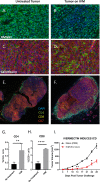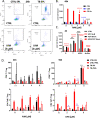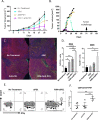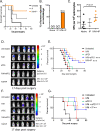Ivermectin converts cold tumors hot and synergizes with immune checkpoint blockade for treatment of breast cancer
- PMID: 33654071
- PMCID: PMC7925581
- DOI: 10.1038/s41523-021-00229-5
Ivermectin converts cold tumors hot and synergizes with immune checkpoint blockade for treatment of breast cancer
Abstract
We show that treatment with the FDA-approved anti-parasitic drug ivermectin induces immunogenic cancer cell death (ICD) and robust T cell infiltration into breast tumors. As an allosteric modulator of the ATP/P2X4/P2X7 axis which operates in both cancer and immune cells, ivermectin also selectively targets immunosuppressive populations including myeloid cells and Tregs, resulting in enhanced Teff/Tregs ratio. While neither agent alone showed efficacy in vivo, combination therapy with ivermectin and checkpoint inhibitor anti-PD1 antibody achieved synergy in limiting tumor growth (p = 0.03) and promoted complete responses (p < 0.01), also leading to immunity against contralateral re-challenge with demonstrated anti-tumor immune responses. Going beyond primary tumors, this combination achieved significant reduction in relapse after neoadjuvant (p = 0.03) and adjuvant treatment (p < 0.001), and potential cures in metastatic disease (p < 0.001). Statistical modeling confirmed bona fide synergistic activity in both the adjuvant (p = 0.007) and metastatic settings (p < 0.001). Ivermectin has dual immunomodulatory and ICD-inducing effects in breast cancer, converting cold tumors hot, thus represents a rational mechanistic partner with checkpoint blockade.
Conflict of interest statement
The authors declare no competing interests.
Figures




Similar articles
-
Modulation of P2X4/P2X7/Pannexin-1 sensitivity to extracellular ATP via Ivermectin induces a non-apoptotic and inflammatory form of cancer cell death.Sci Rep. 2015 Nov 10;5:16222. doi: 10.1038/srep16222. Sci Rep. 2015. PMID: 26552848 Free PMC article.
-
In situ immunogenic clearance induced by a combination of photodynamic therapy and rho-kinase inhibition sensitizes immune checkpoint blockade response to elicit systemic antitumor immunity against intraocular melanoma and its metastasis.J Immunother Cancer. 2021 Jan;9(1):e001481. doi: 10.1136/jitc-2020-001481. J Immunother Cancer. 2021. PMID: 33479026 Free PMC article.
-
Nanodroplet-enhanced sonodynamic therapy potentiates immune checkpoint blockade for systemic suppression of triple-negative breast cancer.Acta Biomater. 2023 Mar 1;158:547-559. doi: 10.1016/j.actbio.2022.12.023. Epub 2022 Dec 17. Acta Biomater. 2023. PMID: 36539109
-
Nano-sized drug delivery systems to potentiate the immune checkpoint blockade therapy.Expert Opin Drug Deliv. 2022 Jun;19(6):641-652. doi: 10.1080/17425247.2022.2081683. Epub 2022 May 30. Expert Opin Drug Deliv. 2022. PMID: 35603410 Review.
-
Combined Radiation Therapy and Immune Checkpoint Blockade Therapy for Breast Cancer.Int J Radiat Oncol Biol Phys. 2017 Sep 1;99(1):153-164. doi: 10.1016/j.ijrobp.2017.05.029. Epub 2017 May 26. Int J Radiat Oncol Biol Phys. 2017. PMID: 28816141 Review.
Cited by
-
Gene signatures to therapeutics: Assessing the potential of ivermectin against t(4;14) multiple myeloma.World J Clin Oncol. 2024 Jan 24;15(1):115-129. doi: 10.5306/wjco.v15.i1.115. World J Clin Oncol. 2024. PMID: 38292661 Free PMC article.
-
Therapeutic vulnerabilities of cancer stem cells and effects of natural products.Nat Prod Rep. 2023 Aug 16;40(8):1432-1456. doi: 10.1039/d3np00002h. Nat Prod Rep. 2023. PMID: 37103550 Free PMC article. Review.
-
Outcome of Ivermectin in Cancer Treatment: An Experience in Loja-Ecuador.Nurs Rep. 2023 Feb 22;13(1):315-326. doi: 10.3390/nursrep13010030. Nurs Rep. 2023. PMID: 36976682 Free PMC article.
-
Comprehensive review of drug-mediated ICD inhibition of breast cancer: mechanism, status, and prospects.Clin Exp Med. 2024 Sep 26;24(1):230. doi: 10.1007/s10238-024-01482-1. Clin Exp Med. 2024. PMID: 39325106 Free PMC article. Review.
-
Ivermectin inhibits the growth of ESCC by activating the ATF4-mediated endoplasmic reticulum stress-autophagy pathway.Acta Biochim Biophys Sin (Shanghai). 2024 Nov 22;57(6):995-1005. doi: 10.3724/abbs.2024210. Acta Biochim Biophys Sin (Shanghai). 2024. PMID: 39574166 Free PMC article.
References
-
- Disis, M. L. & Stanton, S. E. Triple-negative breast cancer: immune modulation as the new treatment paradigm. in American Society of Clinical Oncology Educational Book. American Society of Clinical Oncology. Meeting, e25–e30 (American Society of Clinical Oncology, 2015). - PubMed
-
- Cortés J, et al. LBA21 - KEYNOTE-119: phase III study of pembrolizumab (pembro) versus single-agent chemotherapy (chemo) for metastatic triple negative breast cancer (mTNBC) Ann. Oncol. 2019;30:v859–v860. doi: 10.1093/annonc/mdz394.010. - DOI
Grants and funding
LinkOut - more resources
Full Text Sources
Other Literature Sources
Research Materials

